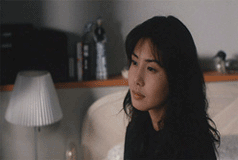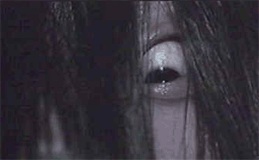|
Newest Reviews:
New Movies -
The Tunnel
V/H/S
The Tall Man
Mama Africa
Detention
Brake
Ted
Tomboy
Brownian Movement
Last Ride
[Rec]≥: Genesis
Hara-Kiri: Death of a Samurai
Indie Game: The Movie
Abraham Lincoln: Vampire Hunter
Old Movies -
Touki Bouki: The Journey of the Hyena
Drums Along the Mohawk
The Chase
The Heiress
Show
People
The Strange Affair of Uncle Harry
Pitfall
Driftwood
Miracle Mile
The Great Flamarion
Dark Habits
Archives -
Recap: 2000,
2001, 2002,
2003, 2004
, 2005, 2006,
2007 , 2008
, 2009 ,
2010 , 2011 ,
2012
All reviews alphabetically
All reviews by star rating
All reviews by release year
Masterpieces
Screening Log
Links
FAQ
E-mail me
HOME
| |
Ring (Hideo Nakata) 1998
 Hideo Nakataís Ring
achieved a good deal of notoriety in Japan when its release became an
unprecedented box office smash, prompting a flurry of sequels, remakes,
spin-offs, and imitations that continues today. Looking at the movie itself, and
trying to ignore the variety of hype and reputation that surrounds it, itís a
surprisingly effective horror thriller. Even if itís been tailor made for
Japanese schoolgirls, it had me screaming like one whenever I wasnít wearing a
big dopey grin and soaking up the filmís considerable ambiance. The movie
follows Nanako (Reiko Asakawa), a reporter who becomes obsessed with the spooky
schoolyard tales that tell of a tape that, when watched, results in the
viewerís death seven days later. Once Nanako tracks the tape down and views
it, the film becomes Candyman with a
countdown. Even if the filmís take on the preponderance and justification of
urban legends in our otherwise myth free lives isnít as astute as the
scholarly approach that Bernard Roseís underrated gem took, it manages to
create a tale that manages to critique our current values as it frightens us.
Hideo Nakataís Ring
achieved a good deal of notoriety in Japan when its release became an
unprecedented box office smash, prompting a flurry of sequels, remakes,
spin-offs, and imitations that continues today. Looking at the movie itself, and
trying to ignore the variety of hype and reputation that surrounds it, itís a
surprisingly effective horror thriller. Even if itís been tailor made for
Japanese schoolgirls, it had me screaming like one whenever I wasnít wearing a
big dopey grin and soaking up the filmís considerable ambiance. The movie
follows Nanako (Reiko Asakawa), a reporter who becomes obsessed with the spooky
schoolyard tales that tell of a tape that, when watched, results in the
viewerís death seven days later. Once Nanako tracks the tape down and views
it, the film becomes Candyman with a
countdown. Even if the filmís take on the preponderance and justification of
urban legends in our otherwise myth free lives isnít as astute as the
scholarly approach that Bernard Roseís underrated gem took, it manages to
create a tale that manages to critique our current values as it frightens us.
 Ringís fear of technology, which is
exemplified by the choice of instruments its demon uses in invoking its terror
(videotape and telephone), seems indicative of a larger cultural discomfort with
such media. That the lead character is a reporter, and a perpetrator of media,
doesnít seem to be lost on the film. The trials that sheís put through would
almost seem to be fitting retribution if they werenít so extreme. The deadline
that looms over Nanakoís head this time seems to be payback for the
exploitation that the media had caused in the past. Since the movieís ending
seems to actually encourage piracy, everything about the film seems to be filled
with self-loathing and a longing for self-destruction that lies just under the
surface. The tape that haunts the characters, while decidedly unsettling,
contains no explicit violence. The video contains an avant garde collection of
eerie images that actually gain a bit of healing power when it leads to the
filmís emotional catharsis. By comparison, the police video of the crime scene
where two of the victims are found that Nanako obtains through her press
privileges feels like a snuff film. Watching it answers nothing, and serves only
the purpose of disturbing us. That a catharsis of sorts can be gleamed from the
picture is not to suggest that Ring is
a touchy-feely ghost story. Itís actually pretty relentless in the trials that
it puts its heroine and her helpful ex-husband through. Nakataís direction
rarely shows off, but the film works well anyway, mostly thanks to the power of
suggestion. Without gore, and with the glimpse of a pair of white shoes, some
distorted photos, and ever-present scary sound effects, the movie builds a
degree of suspense that overcomes any silliness. By the end of Ring,
we understand why the victims of the filmís ghoulish villain were found with
their hearts stopped.
Ringís fear of technology, which is
exemplified by the choice of instruments its demon uses in invoking its terror
(videotape and telephone), seems indicative of a larger cultural discomfort with
such media. That the lead character is a reporter, and a perpetrator of media,
doesnít seem to be lost on the film. The trials that sheís put through would
almost seem to be fitting retribution if they werenít so extreme. The deadline
that looms over Nanakoís head this time seems to be payback for the
exploitation that the media had caused in the past. Since the movieís ending
seems to actually encourage piracy, everything about the film seems to be filled
with self-loathing and a longing for self-destruction that lies just under the
surface. The tape that haunts the characters, while decidedly unsettling,
contains no explicit violence. The video contains an avant garde collection of
eerie images that actually gain a bit of healing power when it leads to the
filmís emotional catharsis. By comparison, the police video of the crime scene
where two of the victims are found that Nanako obtains through her press
privileges feels like a snuff film. Watching it answers nothing, and serves only
the purpose of disturbing us. That a catharsis of sorts can be gleamed from the
picture is not to suggest that Ring is
a touchy-feely ghost story. Itís actually pretty relentless in the trials that
it puts its heroine and her helpful ex-husband through. Nakataís direction
rarely shows off, but the film works well anyway, mostly thanks to the power of
suggestion. Without gore, and with the glimpse of a pair of white shoes, some
distorted photos, and ever-present scary sound effects, the movie builds a
degree of suspense that overcomes any silliness. By the end of Ring,
we understand why the victims of the filmís ghoulish villain were found with
their hearts stopped.
***1/2
02-25-02
Jeremy Heilman
|